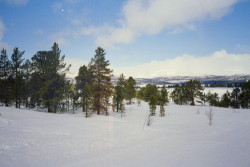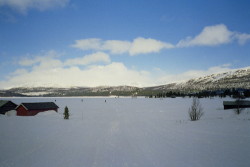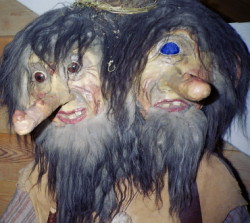 Photo.
Photo. Two-headed troll at
Kvamsfjellet (Kvam Mountain) near Vinstra.
"The royal hall of the king of the Dovre-trolls, a great assembly of
troll-courtiers, gnomes, and brownies. The old man of the Dovre sits on the
throne, crowned, and with his sceptre in his hand. His children and nearest
relations are ranged on both sides. Peer Gynt stands before him (violent
commotion in the hall). The troll-courtiers said: Slay him! A Christian-man's
son has deluded the Dovre-King's loveliest maid!"
! And so the thrill
drama continues.
The world famous author Henrik Ibsen wrote this. He was a Norwegian dramatist,
whose realistic plays dealing with psychological and social problems. This
won him recognition as the creator of modern drama. He was born 20 Mars 1828
in Skien, and died in 23 May 1906.
|
The land of the Trolls - Vinstra in Gudbrandsdalen.
Photo. The Peer Gynt-statue in Vinstra.
At Vinstra and in the surroundings around in Gudbrandsdalen, you will
find the beautiful area which inspired Henrik Ibsen to write his dramatic
masterpiece, Peer Gynt!
Most kind of activities and recreation can be experienced in a
wonderful wilderness between Jotunheimen and Rondane. |
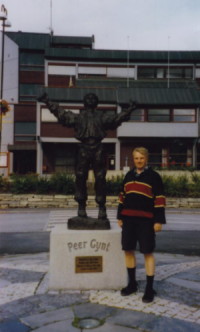 |
Today, just as it was when Ibsen visited the area, Peer
Gynt's Kingdom in Vinstra offers mystery, adventure and inspiration. Peer Gynt
himself in the novel was a real adventurer who travelled many
places in the world, but his greatest experiences was in his own region. Read the novel about Peer Gynt you too, and find inspiration
for great adventures in Vinstra, Gudbrandsdalen.
What`s the origin for trolls? Where
are they actual from? Is it true about
trolls?
The Norwegian Folk tales contain an undertone of realism and folk humour that
makes them unique. There have always been trolls in the Norwegian folklore, but
these old trolls were always ugly, nasty and dangerous. Children were told "If
you don't behave yourself, the trolls will come and take you away!" For them
trolls were very frightening creatures.
Photos. Looking for trolls at the mountain
Kvamsfjellet in Norway (Eastern 2004).
According to ancient Norwegian legends some trolls were
giants and others were small. They all had long crooked noses, only four fingers and
toes on each limb, and most had long bushy tails. The trolls were night creatures,
and direct sunlight could cause them to crack and turn into stone. Perhaps this can
explain why Norway has so many stones, rocks and high mountains.
There are
stories of two-headed as well as three-headed trolls, and even a few with only
one eye in the middle of their wrinkled foreheads. Others have trees and rough
mosslike growth all over their heads and noses. They have supernatural powers,
and do usually bring good luck.
|
Photo. Trolls in Norway mean no harm - as far
you behave yourself.
These hairy creatures have supernatural powers, and do usually
bring good luck. |
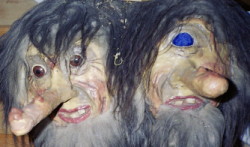 |
The trolls lived to be hundreds of years old. Most were shaggy and looked a
bit frightening, but they were mostly good-natured and naive. Even today it is
well advised to keep a good standing with the trolls. When you go to the forests
and the mountains in Norway, just remember, they probably mean no harm.
But beware. In the twilight hours you are no longer alone. Then it is
only you.....and all the trolls. I just wish you good luck!
Stein Morten Lund, 31 January 2005
Additional information
Gudbrandsdalen in Norway
is the valley with thousand opportunities. This region is in Oppland County,
located in south central Norway. It extends ca. 160 km from the Dovrefjell
south-eastward to Lillehammer on Mjosa lake - Mjøsa lake.
Activity vacations are offered all around in the region and nearby. These
vacations may feature river rafting, bicycling, kayaking, hiking, glacier tours,
cave tours, climbing, fishing, horseback riding, boat tours, reindeer safaris,
elg (moose) safaris and moskus safaris.
It's a rich agricultural and timber district. The Lagan River, which
traverses the valley, is a valuable source of hydroelectric power. The valley
has long been an important trade route and a main invasion route through South
Norway and has a rich history; many Gudbrandsdalen farmers trace their ancestry
back to saga times. Much of the action in Ibsen's Peer Gynt is set there.
Rafting in one of Europe's best and wildest rivers:
Sjoa River is
for white-water rafting. Sjoa is located in Oppland County in Norway. Sjoa,
which is also called the land of the Trolls, is surrounded with high mountains,
and has huge and steep rock walls.
Sjoa River in Gudbrandsdalen floats along the road 257 in the Heidal valley.
The rafting trips here start ca. 8 km from the intersection with E6 road at
Sjoa. It's about 1,5 hours drive north from the Olympic City Lillehammer.
Rafting demands co-operation. It has during years been very popular among
companies which use rafting for teambuilding.
The rafting companies provide the participants with necessary equipment such
as helmets, wetsuits, and life vests, but the participants must bring their own
wool sweaters, wool underwear and thick woollen socks.
Wild and untouched nature:
The area nearby offers the most
fantastic nature you ever have dreamed about. Jotunheimen is a mountain region,
where you find several of the highest mountains in Norway (and the north of
Europe). Among these are: Galdhøpiggen (2469 m), Glittertind (2452 m), Store
Skagastølstind (2405 m) and Fannaråken (2069 m).
The mountain range Jotunheimen is located 350 km north of Oslo, Norway. The
summits are 2000 m or more above sea level, and there are quite a number of
smaller glaciers in the area. Most of Jotunheimen has status as National Park,
which means that special environmental regulations apply, the most important one
being that no motor vehicles are allowed. This makes Jotunheimen ideally suited
for hikers and climbers that enjoy the experience of basically undisturbed
nature.
Spreading north and east from Otta towards the Swedish
border, the Rondane National Park (Rondane Nasjonalpark), established in 1962 as
Norway's first national park, is now one of the country's most popular hiking
areas. Its 580 square kilometres, one-third of which are in the high alpine
zone, appeal to walkers of all ages and abilities. The soil is poor, so
vegetation is sparse and lichens, especially reindeer moss, predominate, but the
views across this bare landscape are serenely beautiful, and a handful of lakes
and rivers along with patches of dwarf birch forest provide some
variety.





 Photo. Two-headed troll at
Kvamsfjellet (Kvam Mountain) near Vinstra.
Photo. Two-headed troll at
Kvamsfjellet (Kvam Mountain) near Vinstra.

